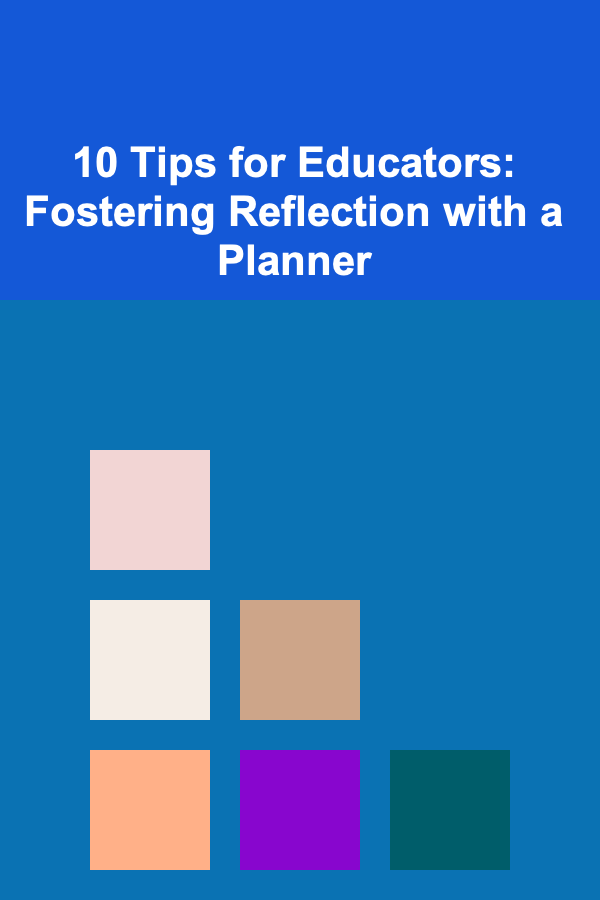
10 Tips for Educators: Fostering Reflection with a Planner
ebook include PDF & Audio bundle (Micro Guide)
$12.99$10.99
Limited Time Offer! Order within the next:

Educators face numerous challenges daily. They juggle lesson planning, student assessments, and the need to remain engaged with professional development. In this environment, it's easy to overlook the importance of reflecting on one's teaching practices. Reflection allows teachers to assess what is working well, identify areas for improvement, and continuously grow as professionals. A planner is one of the most effective tools educators can use to facilitate reflection. By incorporating reflective practices into their daily routines, teachers can improve their effectiveness and enhance student outcomes.
This article provides 10 tips for educators on how to use a planner to foster meaningful reflection in their teaching practices. These tips will help educators stay organized while also allowing them to create intentional time for self-assessment, feedback, and personal growth.
Set Aside Time for Reflection
The first step in using a planner for reflection is to dedicate a specific time for it. Teachers often feel like their days are consumed by lesson planning, grading, and other responsibilities. However, reflection is a key aspect of professional growth that shouldn't be overlooked. By setting aside regular time in your planner to reflect on your teaching experiences, you can ensure that reflection becomes a priority rather than an afterthought.
Tip:
Allocate a 15--30-minute block at the end of each day or week for reflection. This time should be free from distractions, allowing you to review the day or week's lessons, assess your student interactions, and analyze what worked and what didn't.
Use Prompts to Guide Your Reflection
Without guidance, reflection can be vague and unstructured. Using prompts can help focus your thoughts and ensure that your reflections are meaningful and relevant to your professional development. Your planner can include a section where you write down questions that prompt deeper thinking.
Example Prompts:
- What went well in today's lesson, and why?
- What challenges did I face, and how can I address them in the future?
- How did my students respond to the material? Were they engaged?
- Did I manage classroom behavior effectively?
- How did I differentiate instruction to meet the needs of all students?
Tip:
Incorporate a set of prompts for each week or lesson plan. Write your answers directly in your planner to track patterns and insights over time.
Record Student Feedback
Student feedback is a powerful tool for reflection. By gathering input from your students, you gain valuable insights into their learning experience, which can inform your teaching practices. Your planner can include a dedicated section for recording feedback from students, whether it's formal (through surveys or evaluations) or informal (through class discussions or individual conversations).
Tip:
Make a habit of jotting down key feedback from students at the end of each lesson or week. This could include their thoughts on lesson content, teaching style, or any challenges they faced. Over time, this feedback can help you adjust your teaching methods to better suit their needs.
Review Learning Outcomes and Assessments
A critical aspect of teaching is understanding whether students are meeting the desired learning outcomes. Your planner should include space to reflect on how well your students have grasped the material and the effectiveness of the assessments used to measure learning.
Tip:
After each test, quiz, or assignment, reflect on the results. Did most students meet the learning objectives? If not, what adjustments can be made to either the teaching methods or the assessments to improve outcomes in the future?
Track Professional Development Goals
Reflection isn't just about evaluating lessons and student progress; it's also about your own growth as an educator. Your planner should include space for setting and tracking professional development goals. Reflect on the skills or areas you want to develop, whether it's learning new technology, improving classroom management, or exploring different pedagogical techniques.
Tip:
At the beginning of each term or school year, write down a list of professional development goals. Periodically check in with these goals in your planner to assess your progress and make adjustments as necessary.
Analyze Classroom Management Strategies
Classroom management is an area that requires continuous reflection. What strategies are working? What needs improvement? Use your planner to assess how well your classroom management techniques are working and whether your students are responding positively.
Tip:
After each lesson or day, reflect on how your classroom management went. Were students respectful and engaged? Did any issues arise that need to be addressed? Record your strategies and outcomes so you can refine your approach over time.
Organize and Reflect on Personal Well-being
Being an educator is demanding, and teacher burnout is a real concern. It's important to use your planner not only to reflect on your teaching practices but also to check in with your own well-being. Reflection should include an assessment of how you're coping with stress, workload, and personal time management.
Tip:
Include a section in your planner to monitor your mental and physical health. Reflect on your energy levels, stress management, and work-life balance. Schedule time for self-care and ensure that you're taking care of your well-being to avoid burnout.
Keep a Record of Successful Lessons
Your planner can serve as a repository of successful teaching strategies. Each time you create or deliver a lesson that is particularly effective, write down what made it successful. Whether it's a specific activity, teaching method, or student engagement strategy, documenting these successes will allow you to revisit and refine them in the future.
Tip:
After a lesson that goes particularly well, take a moment to write about the strategies you used and what contributed to the success. Use this information to replicate these strategies in future lessons.
Reflect on Student Engagement
Student engagement is one of the most significant factors in the effectiveness of teaching. Your planner should have a space where you can reflect on how engaged your students were during your lessons. Were they actively participating? Did they show interest in the material? How can you increase engagement in future lessons?
Tip:
At the end of each lesson, write a quick note on student engagement. Were they on task? Were they asking questions? Did they seem motivated or distracted? Use this information to tweak your lessons and make them more interactive and engaging.
Use Reflection to Plan for the Future
Reflection isn't just about looking back; it's also about looking forward. Use your planner not only to analyze your past teaching but also to make plans for future improvement. Based on your reflections, set specific goals and outline actions you can take to improve your teaching practices, classroom management, and student outcomes.
Tip:
At the end of each week or month, use the insights gained from your reflections to plan for the upcoming period. This could involve adjusting your lesson plans, incorporating new teaching techniques, or setting specific goals for student learning.
Conclusion
Fostering reflection is a vital part of becoming a more effective and reflective educator. By using a planner as a tool for structured reflection, educators can evaluate their practices, track progress, and continuously grow in their profession. The key is to create a habit of reflecting regularly, making it an intentional part of your teaching routine.
Reflection is not only beneficial for the educator but also for the students. By constantly assessing and refining your practices, you're ensuring that your teaching evolves to meet the changing needs of your learners. So, grab your planner, set aside time for reflection, and start using it as a powerful tool for professional growth and development!
Reading More From Our Other Websites
- [Home Renovating 101] How to Deep Clean Your Carpet for a Spotless and Odor-Free Home
- [Home Pet Care 101] How to Introduce a Pet to a Newborn Baby
- [Simple Life Tip 101] How to Adopt a Minimalist Parenting Approach Without Overcomplicating Family Life
- [Personal Care Tips 101] How to Choose a Lip Balm for Windy Conditions
- [Personal Investment 101] How to Maximize Your Retirement Savings with Smart Investment Choices
- [Organization Tip 101] How to Organize Your Yard Sale by Category for Easy Navigation
- [Personal Investment 101] How to Build a Passive Income Portfolio: Simple Passive Investing Strategies for Beginners
- [Home Budget Decorating 101] How to Refresh Your Home's Look Without Spending a Fortune
- [Home Budget 101] How to Find Budget-Friendly Home Improvement Ideas
- [Home Pet Care 101] How to Choose the Right Pet Grooming Products: A Review & Guide

How to Create a Customer Feedback Management Checklist for Continuous Improvement
Read More
How To Understand the Long-Term Benefits of Frugal Habits
Read More
How to Use Real Estate Investment Trusts (REITs) for Passive Income
Read More
Finding Adventure in the Canyons of Colorado
Read More
How to Build a Cleaning Schedule Planner for Pet Owners
Read More
How to Throw Playing Cards for Divination: A Beginner's Guide
Read MoreOther Products

How to Create a Customer Feedback Management Checklist for Continuous Improvement
Read More
How To Understand the Long-Term Benefits of Frugal Habits
Read More
How to Use Real Estate Investment Trusts (REITs) for Passive Income
Read More
Finding Adventure in the Canyons of Colorado
Read More
How to Build a Cleaning Schedule Planner for Pet Owners
Read More